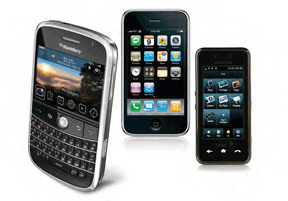Drivers of the small screen interactive revolution
What is going to propel the industry to a new level of interactive digital signage? An insatiable appetite for measurement, and personalization of the retail/shopper relationship.
referenced mobile and when it might “cross the chasm” and serve as the change agent that many preach it to be. We received plenty of encouraging feedback about the progress of mobile, many asking that we touch on the positive aspects that mobile and other emerging small screen technologies have for the future of retail.
SMALL SCREEN INNOVATION AT RETAIL…WHY NOW?
Even in the few months since we wrote our last column, new “small screen interactive” solutions have emerged. The pace in which new, innovative retail solutions pop up is almost dazzling. And it begs the question: Why now?
There are many market drivers for this category; often referred as the “third screen,” or as handheld technologies that utilize some form of rich media. The most important driver is that they are all built to uniquely service consumers rather than advertise to them. They do this by operating as a “pull” device, meaning that they lure a shopper to use them only if they choose to do so. A few others drivers worth noting:
They’re flexible. No matter the flavor of small screen, they are built to accommodate many different strategies. A mobile phone that lets someone SMS for a free coupon can also enable hundreds, if not thousands, of other types of interactivity or call-to-actions. This flexibility has allowed big brands to put some firepower behind it. Apple’s iPhone propelled this even further, as the company’s App Store represents a huge driver of growth on several levels.
They require reduced IT involvement. Anyone that has ever been involved in activating a new technology into the retail store knows how difficult — if not impossible — it can be. There’s good reason however, and it all comes down to security. That said, mobile does not need to run on the store’s IT system, and many of the small interactive screen solutions that have emerged can also work on the wireless network grid. This will be even more alluring when the wireless receptivity issues within stores are 100 percent resolved — which we don’t think is too far off.
They’re portable. Unlike fixed screens, many mobile and handheld devices live alongside our bodies. This means that they can be very targeted to the location of the person carrying them. If that person gives the device permission to track them, they can also be the “ultimate” shopper measurement devices. Which leads to the next key benefit…

WIth larger and more interactive screens, think of today?s handheld technology as portable digital signs. And the devices' functionality enable them to operate as the new "remote control" for digital signage. When it comes down to it, the most important thing we’ve learned is that, the deeper the data you’re collecting, the more pressing the permission issue. Handheld digital screens can operate as a “store cookie,” enabling shoppers to self identify when they want to and opt out just as easily. This may not be a big deal today, but it will be a huge one in the near future when the privacy advocates get serious about our industry.
They’re accountable. Digital screens can be challenging to create an ROI for when they aren’t at least somewhat based on advertising sponsorships. With handheld screens and small digital interactive screens, they track user data that provides brands important shopper insights about what people click on and opt into. This data is highly valuable to marketers and they are willing to pay for it, making an ROI for these devices highly achievable.
Access is getting prolific. This past May, Comscore shared that as of January 2009, 22 million people were accessing the mobile web daily and 63 million monthly. This was up from 11 million and 37 million respectively in 2008. That’s almost double the growth, and they say to expect continued increase. As more people use the mobile web, they also get comfortable using a handheld device to get the information that they need. This will make acceptance for any in-store handheld device easier to come by.
WHAT TO WATCH
So, what’s hot these days? We feel the following deserve a special shout-out, but we would love to hear from anyone out there that has others we should share in the near future.
Near Field transmission: The experts that we trust say that the U.S. is roughly 16 months behind Europe in our sophistication around the use of near field technologies within stores and public places. The good news is that it’s alive and kicking across the pond and those folks are learning valuable lessons that we’ll be privy to. Regarding near field technology, there are huge inroads being made for electronic payment, “permission” marketing, and a plethora of other functionality that doesn’t involve access to the wireless web. This is also called “proximity marketing,” as you need to be near the item of interest to come into its range and do something in response to a marketing message.
Bluetooth: This is a flavor of near field technology. But, as we’ve been fans for years, we’re really excited about the promise of Bluetooth in-store — and the fact that many exciting case studies are currently in the making. The beauty of Bluetooth is that it has now penetrated over 90 percent of mobile phones, making it accessible to most everyone. And, although Apple’s iPhone was not built to function as a Bluetooth device, it’s quite easy to make the phones Bluetooth accessible with one click on the phone settings.
Cellular coupons: I remember spending time in the lab of a major mobile marketing company and trying my darndest to make the POS scanner read the bar code on my phone. No go. Fast forward 5 years and real progress has been made. Kroger made big news this quarter as they launched mobile coupons with a partner. Their solution allows loyalty card members to link their grocery savings card to an online account. The shopper selects the desired coupons and they are loaded to their grocery savings card. The savings are then reflected on the receipt at checkout when the card is presented. This is a workaround to actually scanning a phone, but we expect to see active phone scanning in-store in the next year or two.
Motion detection: Infrared body sensors and other motion detection is serving a solid purpose in that brands can ensure that key digital messages are played when shoppers are nearby. Now, imagine a few years out in the future and that motion detector also identifies the nearby shopper (via opt-in of course!) and pulls content that’s most likely to appeal to that person. This is the real opportunity.
Employee tablets: We adored what Circuit City did to create an associate “digital tablet” built to make even the most novice new hire look like a consumer electronic rock star. This was done by understanding the selling process and the critical information for each product and making it easy for the employee to provide a “guided sell.” This functionality is also ideal for helping a shopper self-service. This is a no-brainer for any retailer today and also carries huge opportunities for allowing shoppers to self-service.
RFID: Finally, RFID prices have dropped significantly. In fact, NEC just announced that they are going to sell them for 90 percent less than competitors in an effort to stimulate market penetration. This will surely make this technology more prolific for inventory management, also making it a likely option for “personalizing” third-screen handheld devices for shoppers.
WHAT ALL THIS MEANS TO YOU
Like everything else, things are happening faster than we can keep up. But, no one can afford to lose the opportunity to gain an edge with one (or many) of the handheld technologies that are out there.
Are there still challenges with them? Certainly. But, being a first mover brings with it the first mover advantage. And, anyone that creatively activates these handheld devices to solve pressing shopper challenges, personalize communications to better serve them (with opt-in in mind), and tailors in-store programs based on the shopper behavior with them has a huge opportunity to gain a competitive edge.
Laura Davis-Taylor (laura@retailmediaconsulting.com) is a 15- year agency veteran with a diverse background in traditional advertising, brand planning, interactive marketing, digital signage, merchandising, and retail/environmental design. She is founder and principal of Retail Media Consulting (www.retailmediaconsulting. com). RMC has just released the first comprehensive guidebook on in-store digital media, and it is available at www.lightinguptheaisle.com

